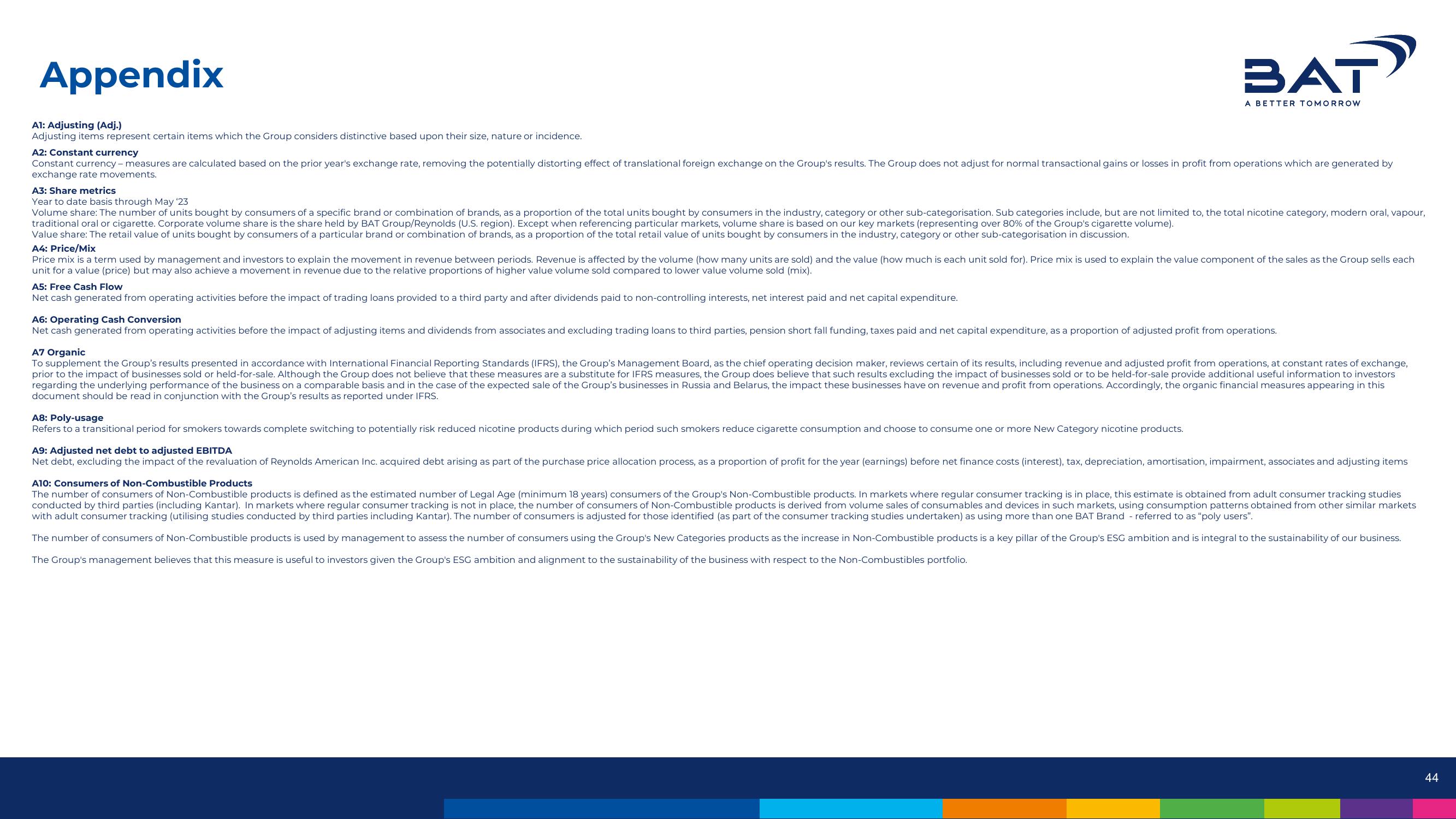BAT Results Presentation Deck
Appendix
BAT
A1: Adjusting (Adj.)
Adjusting items represent certain items which the Group considers distinctive based upon their size, nature or incidence.
A2: Constant currency
Constant currency - measures are calculated based on the prior year's exchange rate, removing the potentially distorting effect of translational foreign exchange on the Group's results. The Group does not adjust for normal transactional gains or losses in profit from operations which are generated by
exchange rate movements.
A BETTER TOMORROW
A3: Share metrics
Year to date basis through May 23
Volume share: The number of units bought by consumers of a specific brand or combination of brands, as a proportion of the total units bought by consumers in the industry, category or other sub-categorisation. Sub categories include, but are not limited to, the total nicotine category, modern oral, vapour,
traditional oral or cigarette. Corporate volume share is the share held by BAT Group/Reynolds (U.S. region). Except when referencing particular markets, volume share is based on our key markets (representing over 80% of the Group's cigarette volume).
Value share: The retail value of units bought by consumers of a particular brand or combination of brands, as a proportion of the total retail value of units bought by consumers in the industry, category or other sub-categorisation in discussion.
A5: Free Cash Flow
Net cash generated from operating activities before the impact of trading loans provided to a third party and after dividends paid to non-controlling interests, net interest paid and net capital expenditure.
A4: Price/Mix
Price mix is a term used by management and investors to explain the movement in revenue between periods. Revenue is affected by the volume (how many units are sold) and the value (how much is each unit sold for). Price mix is used to explain the value component of the sales as the Group sells each
unit for a value (price) but may also achieve a movement in revenue due to the relative proportions of higher value volume sold compared to lower value volume sold (mix).
A6: Operating Cash Conversion
Net cash generated from operating activities before the impact of adjusting items and dividends from associates and excluding trading loans to third parties, pension short fall funding, taxes paid and net capital expenditure, as a proportion of adjusted profit from operations.
A8: Poly-usage
Refers to a transitional period for smokers towards complete switching to potentially risk reduced nicotine products during which period such smokers reduce cigarette consumption and choose to consume one or more New Category nicotine products.
A7 Organic
To supplement the Group's results presented in accordance with International Financial Reporting Standards (IFRS), the Group's Management Board, as the chief operating decision maker, reviews certain of its results, including revenue and adjusted profit from operations, at constant rates of exchange,
prior to the impact of businesses sold or held-for-sale. Although the Group does not believe that these measures are a substitute for IFRS measures, the Group does believe that such results excluding the impact of businesses sold or to be held-for-sale provide additional useful information to investors
regarding the underlying performance of the business on a comparable basis and in the case of the expected sale of the Group's businesses in Russia and Belarus, the impact these businesses have on revenue and profit from operations. Accordingly, the organic financial measures appearing in this
document should be read in conjunction with the Group's results as reported under IFRS.
A9: Adjusted net debt to adjusted EBITDA
Net debt, excluding the impact of the revaluation of Reynolds American Inc. acquired debt arising as part of the purchase price allocation process, as a proportion of profit for the year (earnings) before net finance costs (interest), tax, depreciation, amortisation, impairment, associates and adjusting items
A10: Consumers of Non-Combustible Products
The number of consumers of Non-Combustible products is defined as the estimated number of Legal Age (minimum 18 years) consumers of the Group's Non-Combustible products. In markets where regular consumer tracking is in place, this estimate is obtained from adult consumer tracking studies
conducted by third parties (including Kantar). In markets where regular consumer tracking is not in place, the number of consumers of Non-Combustible products is derived from volume sales of consumables and devices in such markets, using consumption patterns obtained from other similar markets
with adult consumer tracking (utilising studies conducted by third parties including Kantar). The number of consumers is adjusted for those identified (as part of the consumer tracking studies undertaken) as using more than one BAT Brand - referred to as "poly users".
The number of consumers of Non-Combustible products is used by management to assess the number of consumers using the Group's New Categories products as the increase in Non-Combustible products is a key pillar of the Group's ESG ambition and is integral to the sustainability of our business.
The Group's management believes that this measure is useful to investors given the Group's ESG ambition and alignment to the sustainability of the business with respect to the Non-Combustibles portfolio.
44View entire presentation